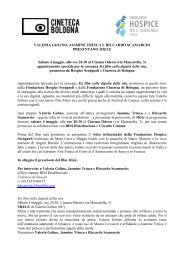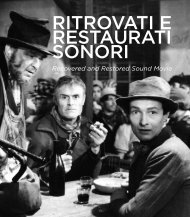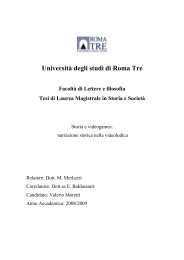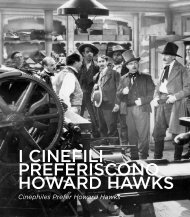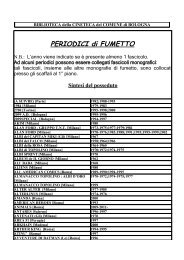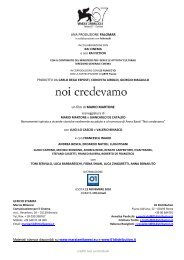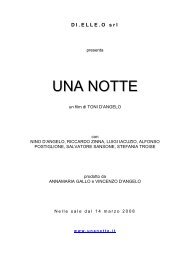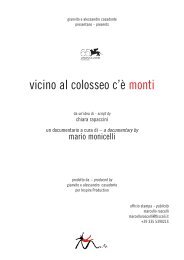Catalogo 1999 - Cineteca di Bologna
Catalogo 1999 - Cineteca di Bologna
Catalogo 1999 - Cineteca di Bologna
Create successful ePaper yourself
Turn your PDF publications into a flip-book with our unique Google optimized e-Paper software.
political opinion, and producers and au<strong>di</strong>ences easily understood each other in the<br />
fictional transpositions of historical plays and films. (The main weakness of<br />
censorship is that it does not understand anything about fiction and its protean<br />
nature.) When in 1927 the noble folk hero of Chuji tabi nikki was hunted by the state<br />
through a series of three films and finally arrested, a betrayed, ill and silenced man,<br />
the Japanese public of the period not only saw a thrilling genre film, but also read it<br />
<strong>di</strong>rectly as a portrait of contemporary politics. The “Laws for Maintaining the<br />
Peace,” introduced in 1925 as the basis for criminalizing the left, were already taking<br />
effect, resulting in waves of arrests, the banning of political parties, trials and<br />
political murders and, finally, the military coup in Manchuria. And that is what the<br />
jidaigeki of those years - the pessimistic ones by Ito Daisuke, Makino Masahiro and<br />
Yamanaka Sadao, and the satirical ones by Itami Mansaku - were about.(...)<br />
Of the trilogy one scene of part two and about haif of part three have been recovered. The overall<br />
structure of the trilogy - described by critics of the period as a succession of dominant moods, from the<br />
“freshness” of the opening installment to the intense “sentiment” of the second part and the “gloomy<br />
nihilism” of the finale - has certainly been lost. But the surviving material contains, in microcosm, a<br />
comparable modulation of mood and, along with it, Chuji’s utter decline from an invincible athletic<br />
hero (cf the come<strong>di</strong>cally-structured scene with the local yakuza boss) to a mute, paralysed body on a<br />
stretcher. The overall weave of graphic and thematic motifs has been lost, but remaining traces (such<br />
as the circle motif of the giant brewery tubs and the children’s ring games) testify to the filmmaker’s<br />
visual sense and creative power. Also lost are most of the formally extravagant passages (the critics<br />
mention accelerated montage sequences or virtuoso camera movements, and Ito Daisuke was<br />
nicknamed “Ido Daisuki,” or “big fan of camera movement”) but the surviving material contains many<br />
instances of perfect filmmaking flair.<br />
(Mariann Lewinsky, “On the Fragment of Chuji Tabi Nikki”, Cinegrafie, 12, <strong>1999</strong>)<br />
Cinema Lumière<br />
ore 11.00<br />
Quarant’anni <strong>di</strong> Cinema Libero: Programma dell’Academy Film Archive / Forty years of free<br />
cinema: Program of the Academy Film Archive<br />
ALLEGRETTO (USA, 1936). R.: Oskar Fischinger. 35mm D.: 2’45’’<br />
MOTION PAINTING No.1 (USA, 1947). R.: Oskar Fischinger. 35mm D.: 11’<br />
FIVE FILM EXERCISES - EXERCISE #4 (USA, 1944). R.: John e James Whitney. 16mm D.: 6’<br />
HOT HOUSE R.: John Whitney. 16mm D.: 3’<br />
CELERY STALKS AT MIDNIGHT R.: John Whitney. D.: 16mm 5’<br />
FIREWORKS (USA, 1947) R.: Kenneth Anger, Curtis Harrigton 16mm<br />
SCORPIO RISING (USA, 1963) R.: Kenneth Anger 16mm<br />
PUCE MOMENT (USA, 1949) R.: Kenneth Anger 16mm<br />
EAUX D’ARTIFICE (USA) R.: Kenneth Anger. 16mm<br />
Alla presenza <strong>di</strong> Kenneth Anger / With special guest Kenneth Anger<br />
ore 16.00



